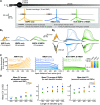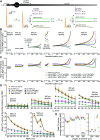NMDA Receptors Enhance the Fidelity of Synaptic Integration
- PMID: 33468538
- PMCID: PMC7932188
- DOI: 10.1523/ENEURO.0396-20.2020
NMDA Receptors Enhance the Fidelity of Synaptic Integration
Abstract
Excitatory synaptic transmission in many neurons is mediated by two coexpressed ionotropic glutamate receptor subtypes, AMPA and NMDA receptors, that differ in kinetics, ion selectivity, and voltage-sensitivity. AMPA receptors have fast kinetics and are voltage-insensitive, while NMDA receptors have slower kinetics and increased conductance at depolarized membrane potentials. Here, we report that the voltage dependency and kinetics of NMDA receptors act synergistically to stabilize synaptic integration of EPSPs across spatial and voltage domains. Simulations of synaptic integration in simplified and morphologically realistic dendritic trees revealed that the combined presence of AMPA and NMDA conductances reduce the variability of somatic responses to spatiotemporal patterns of excitatory synaptic input presented at different initial membrane potentials and/or in different dendritic domains. This moderating effect of the NMDA conductance on synaptic integration was robust across a wide range of AMPA-to-NMDA ratios, and results from synergistic interaction of NMDA kinetics (which reduces variability across membrane potential) and voltage dependence (which favors stabilization across dendritic location). When combined with AMPA conductance, the NMDA conductance compensates for voltage-dependent and impedance-dependent changes in synaptic driving force, and distance-dependent attenuation of synaptic potentials arriving at the axon, to increase the fidelity of synaptic integration and EPSP-spike coupling across both neuron state (i.e., initial membrane potential) and dendritic location of synaptic input. Thus, synaptic NMDA receptors convey advantages for synaptic integration that are independent of, but fully compatible with, their importance for coincidence detection and synaptic plasticity.
Keywords: AMPA receptor; EPSP-spike coupling; NMDA receptor; dendrite; synapse; synaptic integration.
Copyright © 2021 Li and Gulledge.
Figures








Similar articles
-
Glutamate currents in morphologically identified human dentate granule cells in temporal lobe epilepsy.J Neurophysiol. 1997 Jun;77(6):3355-69. doi: 10.1152/jn.1997.77.6.3355. J Neurophysiol. 1997. PMID: 9212280
-
Electrical advantages of dendritic spines.PLoS One. 2012;7(4):e36007. doi: 10.1371/journal.pone.0036007. Epub 2012 Apr 20. PLoS One. 2012. PMID: 22532875 Free PMC article.
-
Functional properties of extrasynaptic AMPA and NMDA receptors during postnatal hippocampal neurogenesis.J Physiol. 2014 Jan 1;592(1):125-40. doi: 10.1113/jphysiol.2013.267203. Epub 2013 Nov 11. J Physiol. 2014. PMID: 24218546 Free PMC article.
-
Contribution of AMPA and NMDA receptors to excitatory responses in the inferior colliculus.Hear Res. 2002 Jun;168(1-2):35-42. doi: 10.1016/s0378-5955(02)00372-6. Hear Res. 2002. PMID: 12117507 Review.
-
Data-driven modeling of synaptic transmission and integration.Prog Mol Biol Transl Sci. 2014;123:305-50. doi: 10.1016/B978-0-12-397897-4.00004-8. Prog Mol Biol Transl Sci. 2014. PMID: 24560150 Free PMC article. Review.
Cited by
-
Neuron-level Prediction and Noise can Implement Flexible Reward-Seeking Behavior.bioRxiv [Preprint]. 2024 May 22:2024.05.22.595306. doi: 10.1101/2024.05.22.595306. bioRxiv. 2024. PMID: 38826332 Free PMC article. Preprint.
-
Glycogen Synthase Kinase 3: Ion Channels, Plasticity, and Diseases.Int J Mol Sci. 2022 Apr 16;23(8):4413. doi: 10.3390/ijms23084413. Int J Mol Sci. 2022. PMID: 35457230 Free PMC article. Review.
-
Synapse-specific diversity of distinct postsynaptic GluN2 subtypes defines transmission strength in spinal lamina I.Front Synaptic Neurosci. 2023 Jul 12;15:1197174. doi: 10.3389/fnsyn.2023.1197174. eCollection 2023. Front Synaptic Neurosci. 2023. PMID: 37503309 Free PMC article.
-
Structural insights into NMDA receptor pharmacology.Biochem Soc Trans. 2023 Aug 31;51(4):1713-1731. doi: 10.1042/BST20230122. Biochem Soc Trans. 2023. PMID: 37431773 Free PMC article. Review.
-
Genome Sequencing of Consanguineous Family Implicates Ubiquitin-Specific Protease 53 (USP53) Variant in Psychosis/Schizophrenia: Wild-Type Expression in Murine Hippocampal CA 1-3 and Granular Dentate with AMPA Synapse Interactions.Genes (Basel). 2023 Oct 9;14(10):1921. doi: 10.3390/genes14101921. Genes (Basel). 2023. PMID: 37895270 Free PMC article.
References
Publication types
MeSH terms
Substances
Grants and funding
LinkOut - more resources
Full Text Sources
Other Literature Sources
